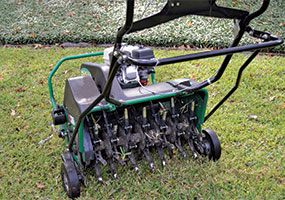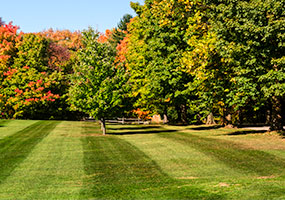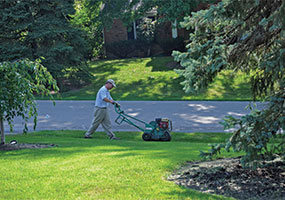Give Me Air…Let Me Breathe!
Newsletters | 08.01.17
KEEPING YOUR LAWN THICK, GREEN AND HEALTHY CALLS FOR AERATION
Could we hear turf talk, we’d hear cries for help and life-giving air. We’re not talking about hospital rooms with oxygen tents. What turf actually needs is to be punched full of holes. The process is called core aeration.

To keep your lawn healthy through periods of stress, the soil must have adequate water, air and nutrients available. Soils that are hard and compacted impede root growth, which prevents the grass plants from developing the deep root system needed to survive hot, dry periods throughout the season.
Core aeration is the process of mechanically removing plugs of thatch and soil from the lawn. Aeration opens the soil, helps reduce compaction, improves water filtration, improves rooting, reduces thatch and acts in many other ways to improve the lawn.
Aeration can be done any time of year but is most effective when the soil is soft and weeds are not actively germinating. It should be done at least once a year, while some lawns need aeration twice a year because of especially heavy soil or traffic.
Proper aeration can reduce water requirements up to 25 percent without harming the grass plant. The cost of the aeration itself can be recovered over a year’s time in water savings alone because the water is getting down to the root zone. It’s not evaporating or getting lost in the thatch layer. The cores left behind stimulate microbial activity to break down the thatch faster and make a better growing medium for your lawn.
With regular aeration the turf clearly benefits. Aeration helps maintain the thatch layer at 1/2 inch or less. There is less stress from disease, and the roots get water and food as well as the air they need.
Aeration is one of the best things you can do for your lawn. Give Blue Tree Landscaping a call today to schedule this valuable service.

Along with aeration, now is a great time for laying new grass seed. While spring may
seem like the logical time to seed barren areas, fall is a better choice. It is a challenge for turf to establish itself in the unpredictable spring. Things get even more difficult for developing turf when heat and weeds come into play during the summer. Seed planted in the spring finds itself thrust into a hostile environment from the get-go.
Seeding now allows your turf to get through its early stages when conditions are ideal. Milder
weather and ample sunshine sets new turf up for success because its roots can take hold free of
summer stresses. While it may be tempting to seed in the spring – seeding in the fall will result in
healthier turf for the long run.
The kids may be back in school, and pools may be closing – but these months are the highlight of
the year for your lawn. A little extra attention now goes a long way towards ensuring its health next
spring, and for years to come.

